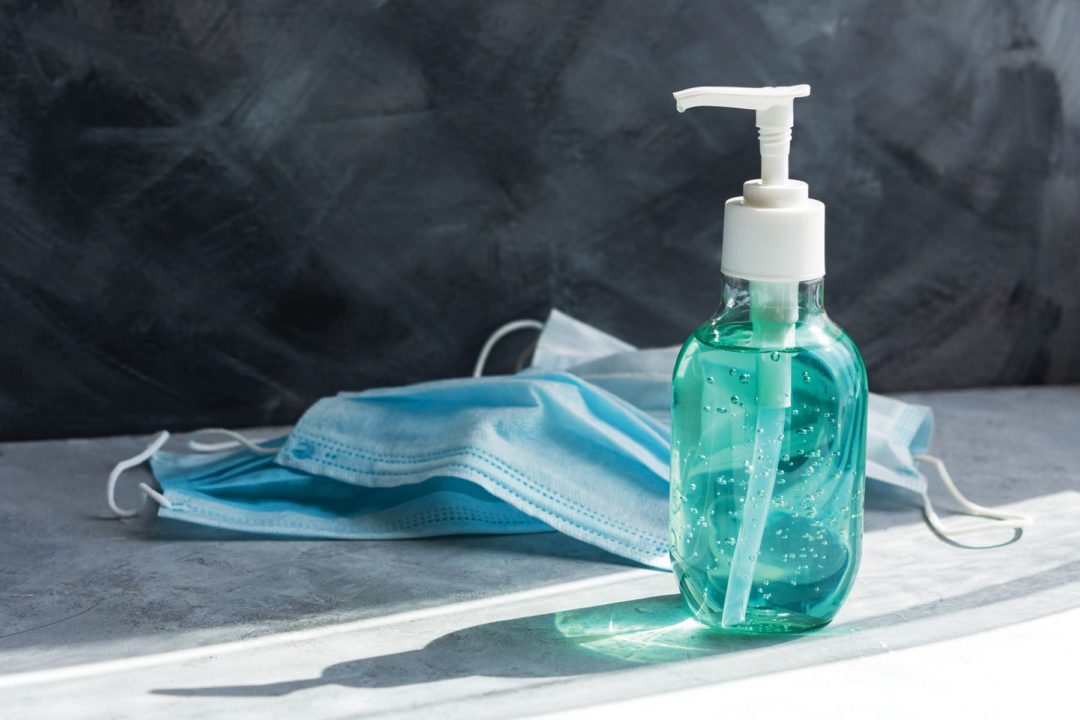As COVID-19 cases were climbing in late November, the Food and Drug Administration (FDA) continued to recall hand sanitizers; the list has grown to 215, as of press time (2). Ingredients on FDA’s “to avoid” list include methanol and 1-propanol.
According to CDC guidelines, hand sanitizers must contain a minimum of 60% alcohol to be effective (often listed on the label as ethanol, ethyl alcohol, isopropanol, or 2-propanol). New research suggests that may not be necessary, though: In December, results were released from a study at Brigham Young University (BYU) finding that alcohol-free hand sanitizer is just as effective at disinfecting surfaces from the COVID-19 virus as alcohol-based products (3). According to a press release, the BYU scientists suspected that the CDC’s recommendation for alcohol sanitizer was linked to as-yet limited research on what really works to disinfect SARS-CoV-2 (4). In the study, the researchers treated samples of the novel coronavirus with benzalkonium chloride, which is commonly used in alcohol-free hand sanitizers. They also tested other quaternary ammonium compounds found in disinfectants. In most of the test cases, the compounds wiped out at least 99.9% of the virus within 15 seconds, according to the release.
“Our results indicate that alcohol-free hand sanitizer works just as well, so we could, maybe even should, be using it to control COVID,” said lead study author Benjamin Ogilvie in the release. “Benzalkonium chloride can be used in much lower concentrations and does not cause the familiar ‘burn’ feeling you might know from using alcohol hand sanitizer. It can make life easier for people who have to sanitize hands a lot, like healthcare workers, and maybe even increase compliance with sanitizing guidelines.” He added that reintroducing alcohol-free sanitizers into the market can help relieve shortages while also helping to minimize potentially “sketchy” alcohol sanitizers that have shown up in the market as demand for sanitizers soared.
While researchers continue to explore the options for non-alcohol and alcohol-based products, let’s take a look at additional ingredients and attributes that add value.
Essential Oils: Tea tree oil, lemongrass, lavender, eucalyptus, peppermint...essential oils add fragrance and antimicrobial properties to hand sanitizers (5).
Moisturizers: Since the main ingredient, alcohol, in hand sanitizer dries out skin, hand sanitizers that moisturize are a pampering plus, especially as we head into the winter and skin starts drying out more frequently. Natural moisturizing agents include aloe, which delivers antiseptic agents and also helps bind moisture into the skin, promoting elasticity and softness (6). Jojoba oil is another soothing natural option. This oil is an emollient; as Christine Ruggeri, CHHC, reports on DrAxe.com, it moisturizes skin and prevents irritations, or scaly and rough patches (7). Glycerin is another common ingredient in hand sanitizers; it helps skin retain moisture. Look for sustainably sourced ingredients, such as in Lily of the Desert’s aloe-infused Hand Sanitizer, which includes glycerin derived from RSPO palm oil and non-GMO rapeseed oil (8).
Probiotics: Probiotics are added to hand sanitizers to help restore skin’s microbiome and good bacteria. One option to look at: kefir. Desert Essence includes it in hand sanitizers to deliver beneficial bacteria to help nourish and condition the skin (9).
Silver: Silver is known to be antimicrobial, and has been used as such for years. One review noted that it has been used in shaving razers, deodorants, shower gels, toothbrush bristles, and more—and that’s just in the personal care sector (10). Products containing high-quality colloidal silver may be appreciated by customers, and it may come in handy for those looking to DIY their hand sanitizer.
Vitamin E: While the main benefit of vitamin E may be reducing UV damage to skin, it is also an antioxidant, and vitamin E oil is a useful moisturizer (11). Many mainstream hand sanitizers, such as Equate and Purell, contain vitamin E, so natural brands containing this ingredient will be able to compare and compete with their mainstream counterparts.
Free-from: Consumers are keen on brands that avoid artificial dyes or fragrances, and that meet the needs of the conscious consumer seeking certified fair-trade, organic, vegan, cruelty-free, and/or B-Corp certified manufactures. WF
DIY Hand Sanitizer
For customers interested in DIY, consider offering ingredients like organic aloe vera gel, essential oils, and rubbing alcohol in bundles with how-to directions for hand sanitizer.NOW Foods offers DIY hand sanitizer recipes with links to products. Visit www.nowfoods.com/now/recipes/diy-hand-cleanser for more information. Katie Wells, CTNC, MCHC, Wellness Mama Blogger, also offers several hand sanitizer recipes. Check out this “Stronger Hand Sanitizer Recipe,” courtesy of Wellness Mama:
Ingredients: • 1 Tbsp. rubbing alcohol • 1/2 tsp vegetable glycerin (optional) • 1/4 cup aloe vera gel • 20 drops Germ Destroyer oil • 1 Tbsp. distilled water or colloidal silver/ionic silver for extra antibacterial power • other essential oils (for scent)
For directions, visit www.wellnessmama.com/281/homemade-hand-sanitizer/.










